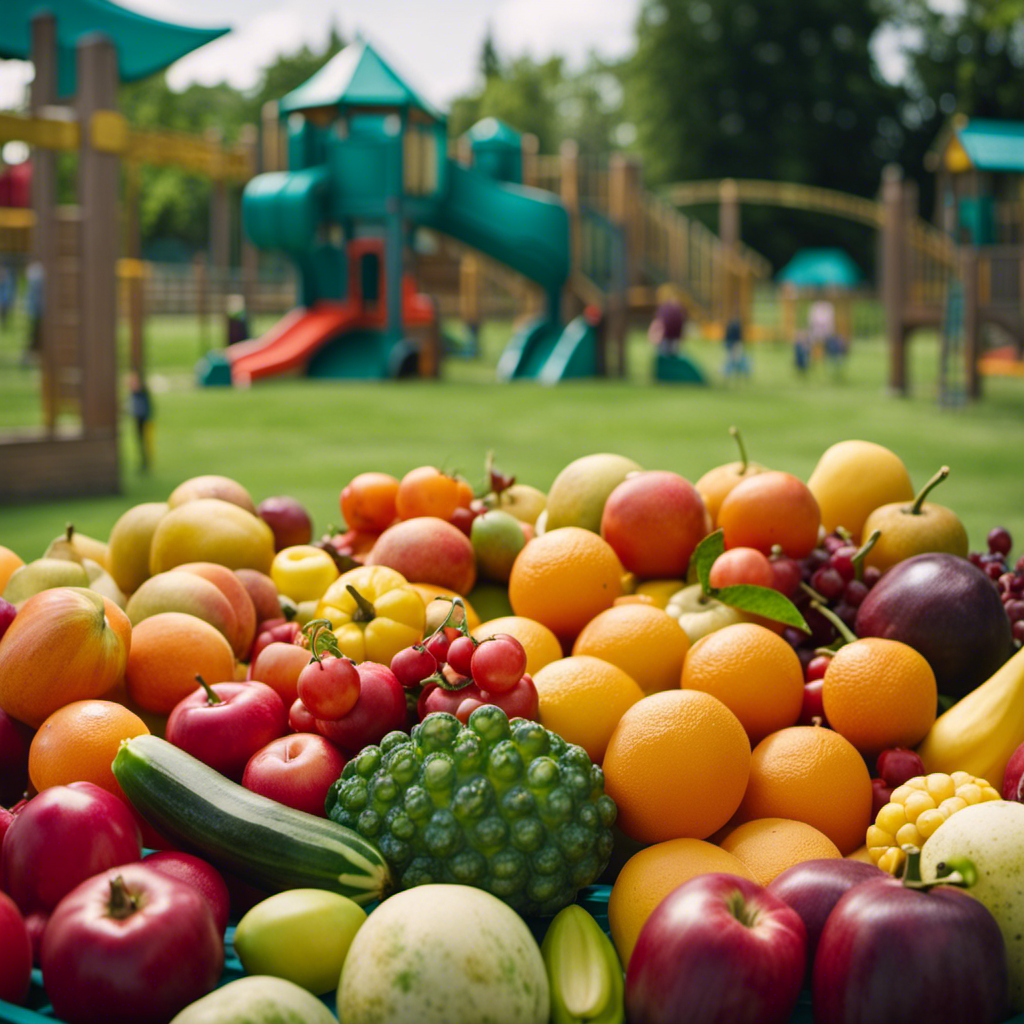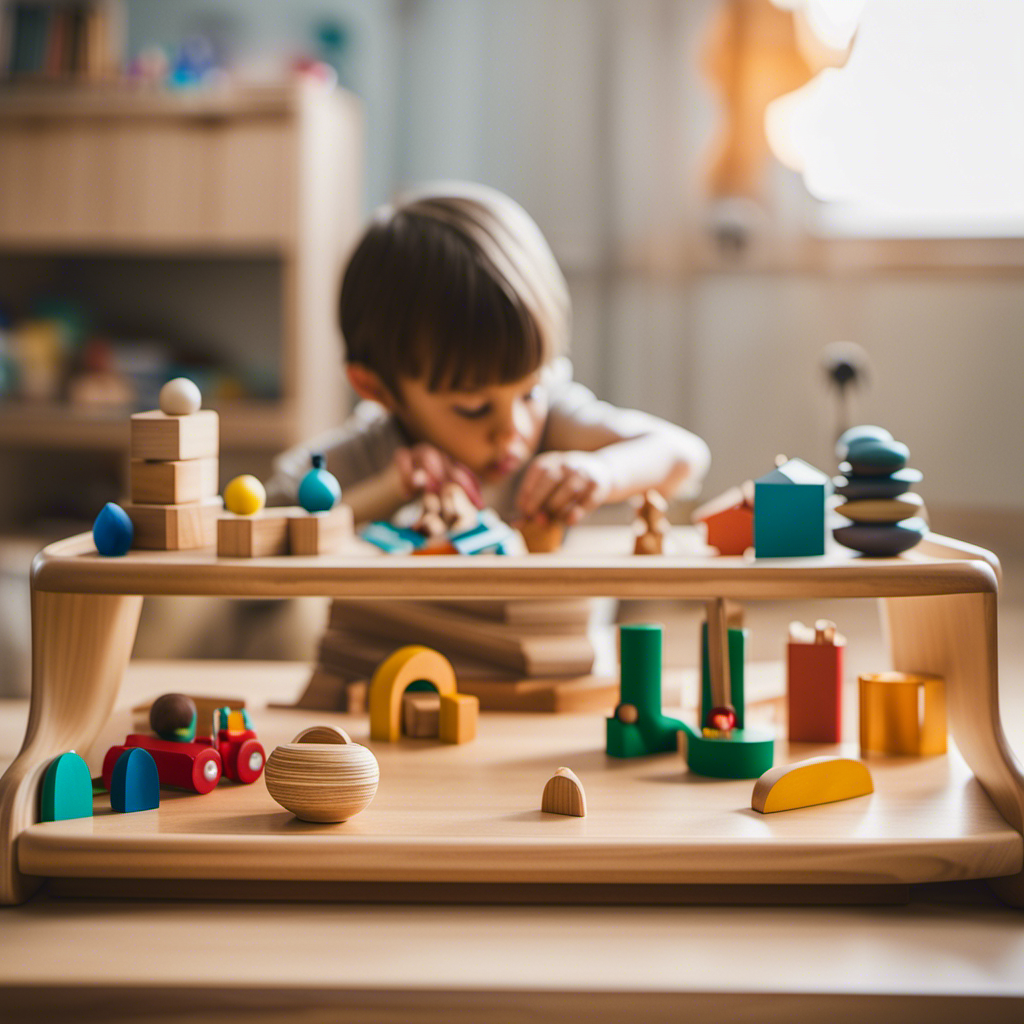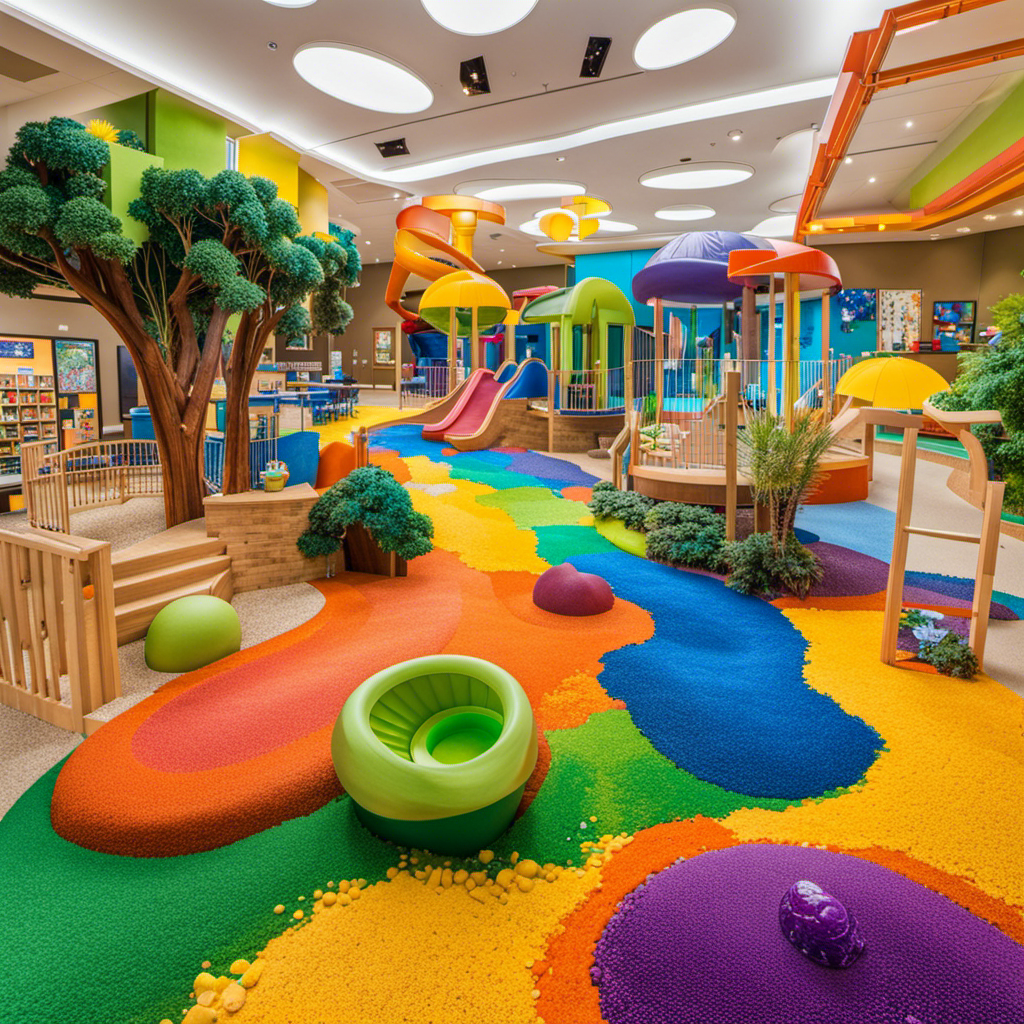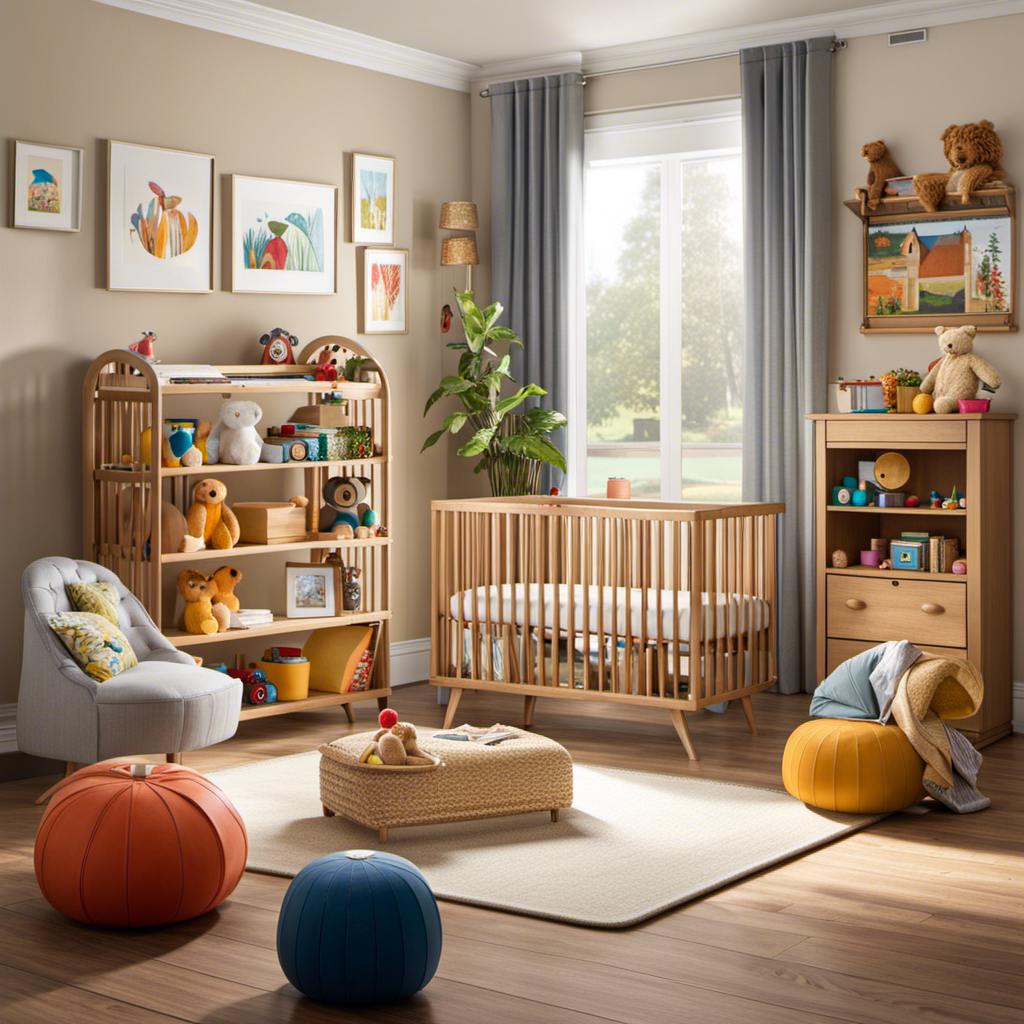As a parent, I often think about how nutrition affects my child’s development. This curiosity has motivated me to embark on a journey of research and discovery.
And what I’ve found is truly fascinating. Proper nutrition plays a crucial role in supporting every aspect of a child’s growth, from physical to emotional development.
In this article, we will delve into the importance of nutrition for child development, exploring the effects of malnutrition, the role of macronutrients and micronutrients, and the lifelong benefits of good nutrition in childhood.
Key Takeaways
- Proper nutrition is essential for physical, cognitive, emotional, and social development in children.
- Malnutrition can result in stunted growth, delayed cognitive development, and increased vulnerability to infections.
- A well-balanced diet reduces the risk of chronic diseases in adulthood.
- Parents should prioritize their child’s nutrition by offering a variety of nutritious foods and limiting sugary snacks and beverages.
The Importance of Proper Nutrition for Child Development
Proper nutrition is crucial for a child’s development. It not only supports their physical growth, but also their cognitive, emotional, and social development. Nutritional interventions during early childhood can have long-term effects on a child’s overall health and well-being.
Research shows that malnutrition can have detrimental effects on a child’s development. Insufficient intake of essential nutrients such as vitamins, minerals, and proteins can lead to stunted growth, delayed cognitive development, and increased susceptibility to infections. On the other hand, a well-balanced diet that meets the nutritional requirements of a growing child can promote healthy development and reduce the risk of chronic diseases later in life.
As a parent or caregiver, it is important to prioritize your child’s nutrition by providing them with a variety of nutritious foods. This includes fruits, vegetables, whole grains, lean proteins, and dairy products. Additionally, limiting the consumption of sugary snacks and beverages can help prevent the development of unhealthy eating habits.
Nutritional Requirements for Healthy Child Growth
When it comes to the growth and development of children, proper nutrition plays a vital role. Essential nutrients are necessary for their growth and overall health.
Malnutrition can have a significant impact on a child’s physical and cognitive development. Therefore, it is crucial to provide children with a balanced diet that includes a variety of nutrient-rich foods to support their growth and well-being.
Essential Nutrients for Growth
You need to ensure you’re getting enough essential nutrients for your growth. Proper nutrition is crucial for your overall development, especially during childhood. Nutritional needs vary depending on age, sex, and individual factors. To support optimal growth, it is important to consume a balanced diet that includes all the necessary nutrients. Here is a table outlining some key nutrients and their role in growth:
| Nutrient | Role in Growth |
|---|---|
| Protein | Building blocks for tissues |
| Calcium | Strong bones and teeth |
| Iron | Oxygen transport in the body |
| Vitamin C | Collagen synthesis and wound healing |
| Vitamin D | Calcium absorption and bone health |
These essential nutrients work in harmony with growth hormones to ensure proper development. In the next section, we will explore the impact of malnutrition on child development, highlighting the consequences of inadequate nutrient intake.
Impact of Malnutrition
Malnutrition can have serious consequences on a child’s overall growth and well-being. The impact of poverty often leads to inadequate access to nutritious food, resulting in malnutrition among children. This not only affects their physical development but also compromises their immune system.
When children do not receive the necessary nutrients, their immune system weakens, making them more susceptible to infections and diseases. Malnutrition can impair the production and function of immune cells, reducing the body’s ability to fight off infections. It can also lead to delayed wound healing and increased recovery time from illnesses.
Therefore, addressing malnutrition is crucial to ensure children’s immune system functions optimally. Moving forward, it is essential to understand the role of a balanced diet in promoting overall health and well-being.
Role of Balanced Diet
A balanced diet plays a crucial role in promoting overall health and well-being by providing essential nutrients for proper growth and immune system function. When it comes to children, establishing good nutritional habits early on is vital for their development.
Encouraging dietary diversity is key to ensuring that children receive a wide range of nutrients necessary for their growth and development. By offering a variety of fruits, vegetables, whole grains, lean proteins, and dairy products, we can provide children with the necessary vitamins, minerals, and antioxidants they need to thrive.
Additionally, a balanced diet helps children maintain a healthy weight, reduces the risk of chronic diseases, and supports their cognitive function and concentration. By ensuring that children have access to a balanced diet, we can set them up for a healthy and successful future.
Inadequate nutrition, on the other hand, can have detrimental effects on a child’s development.
Effects of Malnutrition on Child Development
The impact of malnutrition on child development can be significant and long-lasting. Malnutrition occurs when a child’s body does not receive adequate nutrients to support healthy growth and development. It can have several detrimental effects on a child’s overall well-being.
-
Stunted growth: Malnutrition can lead to stunted growth, where a child fails to reach their full height potential. This can have long-term consequences on their physical health and self-esteem.
-
Impaired cognitive development: Lack of proper nutrition can hinder brain development, leading to cognitive impairments. Children who experience malnutrition may have difficulties with learning, memory, and problem-solving.
-
Weakened immune system: Malnourished children are more susceptible to infections and illnesses due to their weakened immune systems. This can result in frequent illnesses and prolonged recovery periods.
To address these issues, nutritional interventions are crucial. Providing children with a balanced diet that includes a variety of essential nutrients can help mitigate the long-term effects of malnutrition. By ensuring access to a diverse range of foods that are rich in macronutrients like carbohydrates, proteins, and fats, we can support optimal child development.
Understanding the effects of malnutrition on child development highlights the importance of addressing nutritional needs from an early age. Transitioning to the next section, we will explore the role of macronutrients in supporting child development.
The Role of Macronutrients in Supporting Child Development
In the previous section, we explored the harmful effects of malnutrition on child development. Now, let’s shift our focus to the role of macronutrients in supporting healthy growth and development in children. Macronutrients are the nutrients that our bodies need in large quantities, and they include proteins, carbohydrates, and fats.
Proteins are essential for the growth and repair of tissues in the body. They are made up of amino acids, which are the building blocks of life. Children need protein to support the development of their muscles, bones, and organs. Good sources of protein include lean meats, poultry, fish, eggs, dairy products, beans, and nuts.
Carbohydrates are the body’s main source of energy. They provide the fuel that children need to play, learn, and grow. Healthy sources of carbohydrates include fruits, vegetables, whole grains, and legumes.
Fats are important for brain development and the absorption of fat-soluble vitamins. They also provide insulation and protection for organs. It is crucial for children to consume healthy fats, such as those found in avocados, nuts, seeds, and fatty fish.
While macronutrients play a vital role in child development, it is important to note that micronutrients, such as vitamins and minerals, are equally important. In the next section, we will explore the impact of micronutrients on child development and growth.
Micronutrients and Their Impact on Child Development
Make sure you’re getting enough micronutrients in your diet to support your child’s development. Micronutrients are essential for proper growth and development in children. Here are three important facts about micronutrients and their impact on child development:
-
Micronutrient deficiencies can hinder your child’s development: Micronutrients such as iron, zinc, iodine, and vitamin A play crucial roles in brain development, immune function, and overall growth. Deficiencies in these micronutrients can lead to cognitive impairments, stunted growth, weakened immune system, and increased susceptibility to infections.
-
Micronutrient supplementation can help bridge the gap: In some cases, it may be challenging to meet your child’s micronutrient needs through diet alone. Micronutrient supplementation, under the guidance of a healthcare professional, can help fill any nutrient gaps and ensure your child receives adequate amounts of essential micronutrients.
-
Balanced diet is key: While supplementation can be beneficial, it should not replace a healthy and balanced diet. Encourage your child to eat a variety of nutrient-rich foods such as fruits, vegetables, whole grains, lean proteins, and dairy products. This will ensure they receive a wide range of micronutrients necessary for their optimal development.
Ensuring your child gets enough micronutrients is just one aspect of supporting their development. Another important factor is the influence of breastfeeding on child development.
The Influence of Breastfeeding on Child Development
To support your child’s development, it’s important to understand how breastfeeding influences their growth and well-being. Breastfeeding has numerous benefits for both the baby and the mother. The World Health Organization recommends exclusive breastfeeding for the first six months of life, followed by continued breastfeeding alongside appropriate complementary foods for up to two years or beyond.
Breast milk contains the perfect combination of nutrients that are essential for a baby’s growth and development. It provides all the necessary vitamins, minerals, and antibodies that help protect against infections and diseases. Breastfeeding has been linked to a reduced risk of respiratory infections, ear infections, allergies, obesity, and even certain chronic diseases later in life.
The duration of breastfeeding is also important. Studies have shown that longer breastfeeding duration is associated with better cognitive development, improved IQ scores, and enhanced language skills. Breastfeeding promotes bonding between the mother and baby, and the skin-to-skin contact during breastfeeding releases hormones that contribute to the baby’s emotional well-being.
Understanding the benefits of breastfeeding is just the first step in supporting your child’s development. The next section will explore the role of early childhood nutrition in brain development and how it impacts your child’s overall growth and cognitive abilities.
Early Childhood Nutrition and Brain Development
Understanding the importance of early childhood nutrition and its impact on brain development is crucial for supporting your child’s overall growth and cognitive abilities. Proper nutrition during this critical period plays a significant role in language development and social development.
Research has shown that certain nutrients, such as omega-3 fatty acids and iron, are essential for optimal brain development in children. These nutrients help build and strengthen the neural connections in the brain, which are important for language development. A deficiency in these nutrients can lead to delays in language acquisition and communication skills.
Furthermore, nutrition also plays a role in social development. A well-balanced diet that includes a variety of fruits, vegetables, and whole grains can provide essential vitamins and minerals that support social-emotional development. For example, zinc and vitamin B6 have been linked to improved social skills and reduced behavioral problems in children.
To help you understand the significance of early childhood nutrition on brain development, here is a table highlighting some key nutrients and their impact:
| Nutrient | Impact on Brain Development |
|---|---|
| Omega-3 fatty acids | Enhances language development and cognitive abilities |
| Iron | Supports brain function and prevents cognitive impairments |
| Zinc | Promotes social skills and emotional well-being |
| Vitamin B6 | Reduces behavioral problems and supports brain health |
| Vitamin D | Plays a role in neuronal development and cognitive function |
Nutrition and Physical Development in Children
As a child grows, proper nutrition plays a crucial role in their physical development. It supports key aspects such as growth and bone health, muscle strength and coordination, and cognitive and motor skills.
Research has shown that providing children with a well-balanced diet, rich in essential nutrients, not only aids their physical growth but also enhances their overall development, allowing them to reach their full potential.
Growth and Bone Health
Proper nutrition is crucial for children’s growth and bone health. During childhood, growth and development occur at a rapid pace, and nutrition plays a vital role in supporting these processes.
Adequate intake of essential nutrients such as calcium, vitamin D, and protein is necessary for the development of strong and healthy bones. Calcium is particularly important for bone density, as it helps to build and maintain strong bones. Vitamin D, on the other hand, aids in the absorption of calcium from the diet. Protein is essential for the formation of new bone tissue and the repair of any damage.
Muscle Strength and Coordination
Muscle strength and coordination are important for children’s overall physical development. As children grow, their muscles develop and become stronger, allowing them to perform various movements and activities. Muscle development is closely linked to motor skills development, as it enables children to have better control over their bodies and perform tasks such as walking, running, jumping, and throwing.
Through regular physical activity and play, children can enhance their muscle strength and coordination. Activities like climbing, swinging, and playing sports help to strengthen different muscle groups and improve overall coordination. This physical development is crucial for children to engage in daily activities and explore their environment.
In the next section, we will discuss how nutrition plays a role in supporting cognitive and motor skills development.
Cognitive and Motor Skills
To improve cognitive and motor skills, engaging in activities that challenge the brain and body is key.
Cognitive development refers to the growth and development of thinking, learning, and problem-solving skills. Children can enhance their cognitive abilities by participating in activities such as puzzles, reading, and memory games.
Physical coordination, on the other hand, involves the ability to use different parts of the body together efficiently. Activities like sports, dancing, and playing musical instruments can improve physical coordination.
Both cognitive development and physical coordination are essential for overall child development.
Now, let’s explore the link between nutrition and cognitive development.
The Link Between Nutrition and Cognitive Development
There’s a clear connection between nutrition and how a child’s brain develops. Good nutrition plays a vital role in a child’s cognitive development, which includes their ability to learn, think, and problem-solve. Research has shown that proper nutrition is linked to better academic performance and improved executive functions in children.
When it comes to academic performance, studies have consistently found that children who consume a balanced diet perform better in school. Nutrients such as omega-3 fatty acids, iron, zinc, and B vitamins have been shown to have a positive impact on cognitive abilities. These nutrients support the development of brain cells and neural connections, enhancing learning and memory.
Furthermore, nutrition is closely tied to executive functions, which are crucial for a child’s ability to plan, organize, and control impulses. Nutrients like iron, zinc, and vitamin D have been found to influence executive skills such as attention, working memory, and cognitive flexibility. Adequate intake of these nutrients is associated with better self-regulation and problem-solving abilities in children.
As we explore the connection between nutrition and child development, it’s important to consider not only cognitive development but also emotional and behavioral development. Nutrition plays a significant role in these areas as well, impacting a child’s overall well-being and development.
Emotional and Behavioral Development and Nutrition
When it comes to a child’s emotional and behavioral development, nutrition plays a crucial role. Nutritional deficiencies can have a significant impact on a child’s behavior, affecting their ability to concentrate, regulate their emotions, and even their overall mood.
On the other hand, a balanced and nutritious diet can support emotional well-being, promote positive behavior, and contribute to a child’s overall mental health and development.
Nutritional Deficiencies and Behavior
You should be aware of how nutritional deficiencies can impact your child’s behavior. Behavioral disorders in children can often be linked to nutrient deficiencies. Here are some ways in which this connection can affect your child emotionally and behaviorally:
- Nutrient deficiencies can lead to irritability and mood swings, making it difficult for your child to regulate their emotions.
- Lack of certain vitamins and minerals can affect brain function, leading to impulsivity and difficulty concentrating.
- For example, a deficiency in omega-3 fatty acids has been linked to increased risk of attention-deficit/hyperactivity disorder (ADHD) symptoms.
- Additionally, low levels of iron have been associated with poor cognitive function and increased aggression in children.
Understanding the impact of nutrient deficiencies on behavior is crucial for promoting your child’s emotional well-being and overall development. A balanced and nutrient-rich diet plays a vital role in supporting their mental health and emotional stability.
Emotional Well-Being and Diet
To support your child’s emotional well-being, it’s important to consider how their diet can impact their mood and overall mental health. Research has shown a clear relationship between nutrition and mental health in children.
A balanced diet rich in nutrients can have a positive impact on emotional well-being and academic performance. For example, omega-3 fatty acids found in fish can improve cognitive function and reduce symptoms of depression and anxiety. Additionally, a diet high in fruits, vegetables, and whole grains provides essential vitamins and minerals that support brain health and regulate mood.
On the other hand, a diet high in processed foods, sugars, and artificial additives has been linked to increased risk of mental health issues. Therefore, ensuring your child’s diet is balanced and nutritious can play a crucial role in promoting their emotional well-being and overall mental health.
Transitioning into the next section, let’s now explore the impact of balanced nutrition on child development.
Impact of Balanced Nutrition
In my previous section, I talked about how emotions can be influenced by our diet. Now, let’s explore the impact of balanced nutrition on child development.
Nutritional habits and dietary patterns play a crucial role in a child’s overall well-being and growth. Here are four key ways in which balanced nutrition can positively affect a child’s development:
-
Cognitive development: Proper nutrition, including essential nutrients like omega-3 fatty acids and iron, supports brain development and enhances cognitive functions such as memory and problem-solving skills.
-
Physical growth: A balanced diet rich in proteins, vitamins, and minerals promotes healthy growth and development of muscles, bones, and organs.
-
Immune system strength: Nutritious foods provide the necessary vitamins and minerals that boost the immune system, helping children fight off illnesses and infections.
-
Energy levels and mood: A well-balanced diet ensures an adequate intake of carbohydrates and proteins, providing the energy needed for physical activities and maintaining a stable mood.
Nutritional Strategies for Supporting Child Development
When it comes to supporting your child’s development, implementing nutritional strategies is key. Proper nutrition plays a crucial role in the overall growth and development of children. By providing them with a balanced diet, we can ensure that they receive the necessary nutrients for optimal development. There are various nutritional interventions and dietary guidelines that can be followed to promote your child’s well-being.
One effective strategy is to encourage a diverse and nutrient-rich diet. This can be achieved by incorporating a wide range of fruits, vegetables, whole grains, lean proteins, and healthy fats into their meals. Additionally, limiting the intake of sugary drinks and processed foods can help prevent nutritional deficiencies and promote healthy growth.
To make it easier to understand, here is a table summarizing some key nutritional strategies for supporting child development:
| Nutritional Strategies | Benefits |
|---|---|
| Encourage a diverse diet | Provides a wide range of essential nutrients |
| Limit sugary drinks and processed foods | Prevents nutritional deficiencies |
| Ensure adequate intake of fruits and vegetables | Promotes overall health and well-being |
| Include lean proteins and healthy fats | Supports growth and development |
By following these strategies, parents can provide their children with the foundation for healthy development. However, it is important to address the nutritional challenges that may arise in child development.
Transitioning into the subsequent section about addressing nutritional challenges in child development, it is important to consider the specific needs of children and the potential barriers they may face in obtaining proper nutrition.
Addressing Nutritional Challenges in Child Development
You can overcome nutritional challenges in your child’s development by implementing strategies that prioritize their dietary needs and address potential barriers. Addressing malnutrition challenges and promoting healthy eating habits are essential for supporting your child’s growth and development. Here are three key strategies to help you in this journey:
-
Provide a variety of nutrient-rich foods: Offer a colorful plate filled with fruits, vegetables, whole grains, lean proteins, and dairy products. This ensures that your child receives a wide range of vitamins, minerals, and other essential nutrients necessary for their development.
-
Create a positive eating environment: Make mealtimes enjoyable and stress-free. Sit together as a family, turn off screens, and engage in pleasant conversations. Encourage your child to listen to their hunger and fullness cues, and allow them to have some control over their food choices.
-
Teach healthy eating habits: Educate your child about the importance of balanced meals and the benefits of making nutritious choices. Involve them in grocery shopping, meal planning, and cooking activities. Encourage them to try new foods and explore different flavors.
The Lifelong Benefits of Good Nutrition in Childhood
In my previous discussion, I talked about the challenges we face in ensuring proper nutrition for children. Now, I want to highlight the long-term benefits of good nutrition in childhood.
Early childhood nutrition plays a crucial role in a child’s academic performance. Studies have consistently shown that children who have access to nutritious meals perform better in school. Proper nutrition provides the energy and nutrients needed for brain development and cognitive functioning. When children eat well-balanced meals, they are more focused, have better memory retention, and exhibit improved problem-solving skills.
Furthermore, good nutrition in childhood has a significant impact on preventing chronic diseases in adulthood. Research has demonstrated that early nutrition can influence a child’s risk of developing conditions like obesity, diabetes, and heart disease later in life. Providing children with a diet rich in fruits, vegetables, whole grains, and lean proteins sets the stage for a healthy adulthood. By instilling healthy eating habits early on, we can help reduce the risk of chronic diseases and promote lifelong wellness.
It is clear that early childhood nutrition has far-reaching benefits. By ensuring children have access to nutritious meals, we can support their academic success and lay the foundation for a healthy future.
Frequently Asked Questions
How Does Nutrition Impact a Child’s Social Development?
Nutrition plays a crucial role in a child’s social development. Proper nutrition affects a child’s behavior and can impact their cognitive development. When a child receives the necessary nutrients, their brain develops optimally, allowing them to learn and engage with others effectively.
Good nutrition also provides the energy and nutrients needed for social interactions, allowing children to engage in activities, make friends, and develop important social skills. Therefore, nutrition is a key factor in supporting a child’s social development.
What Are Some Common Nutritional Challenges That Children May Face?
When it comes to nutrition, kids can be a real challenge. I mean, who wants to eat their broccoli when there’s ice cream in the world?
But let’s talk about some common nutritional challenges that children face. One big issue is common nutritional deficiencies, like not getting enough vitamins and minerals.
Luckily, there are strategies to improve children’s nutrition, like offering a variety of healthy foods and setting a good example by eating well ourselves.
Can Poor Nutrition in Childhood Have Long-Term Effects on Adult Health?
Poor nutrition in childhood can have long-term consequences on adult health. Research has shown that inadequate nutrition during childhood can lead to various developmental outcomes, such as stunted growth, cognitive impairments, and increased risk of chronic diseases later in life.
It is crucial to provide children with a balanced diet that includes essential nutrients for their overall growth and development. By promoting healthy eating habits early on, we can help ensure better health outcomes for children as they grow into adulthood.
How Does Nutrition Affect a Child’s Ability to Concentrate and Learn in School?
Nutrition plays a crucial role in a child’s ability to concentrate and learn in school. A well-balanced diet, including essential nutrients like vitamins, minerals, and proteins, provides the fuel needed for optimal brain function.
Adequate nutrition supports cognitive development, memory, and attention span, all of which contribute to improved academic performance.
On the other hand, poor nutrition, such as diets high in processed foods and lacking in essential nutrients, can hinder a child’s ability to focus and learn effectively in the classroom.
Are There Specific Foods or Nutrients That Can Support a Child’s Emotional Well-Being and Mental Health?
As a child, I’ve always wondered about the impact of specific nutrients on my emotional well-being. It’s fascinating to think that the food I eat can actually affect how I feel.
Research has shown that certain nutrients, such as omega-3 fatty acids found in fish, can support emotional well-being and mental health in children. These nutrients help regulate neurotransmitters in the brain that play a crucial role in managing emotions.
Conclusion
In conclusion, nutrition is the cornerstone of a child’s development, shaping their future in profound ways.
Just as a seed needs nourishment to grow into a strong tree, a child needs proper nutrition to thrive and reach their full potential.
Just like the roots of a tree provide stability, a child’s nutritional foundation supports their physical, cognitive, and emotional growth.
By providing them with a balanced diet rich in essential nutrients, we are giving them the tools they need to blossom into healthy and successful individuals.
Remember, good nutrition is the key to unlocking a child’s limitless potential.
Avery brings the magic of words to life at Toddler Ride On Toys. As a dedicated writer, she combines her love for writing with her fascination for child development to craft articles that resonate with our audience. With a background in journalism and a knack for storytelling, Avery’s pieces inform, engage, and inspire parents and caregivers.










